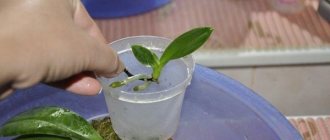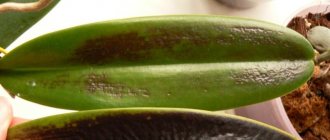The orchid may become sick and die as a result. Timely resuscitation measures will help bring the plant back to life. In the process of growing a flower, you need to take into account that it is much easier to save a dried orchid than an over-watered one. It is best to place the orchid in a transparent container to monitor the condition of the roots and watering. The plant must be placed in a well-lit place, but remember that direct sunlight has a negative effect on it and therefore the exposure should be diffuse.
How to understand that the root system is not functioning?
Phalaenopsis is a fairly viable plant, so you may not suspect that something is wrong with it for a long time. If you notice any changes in the condition of the flower, for example yellowed leaves, you should remove it from the flowerpot and inspect the root system.
Living and healthy roots should be green or white; if there is not enough light, they can be brownish, always hard and dense to the touch, while rotten roots crumble under your fingers and become hollow. If you press on them, moisture will be released, and if the situation is completely advanced, they will crawl under your fingers. In this case, the root system can no longer be saved.
“Phalaenopsis without roots” is a plant falling apart with a dying bottom and a few leaves near the growing point. It is necessary to immediately cut off everything that has rotted and dried out, and begin resuscitation of the flower.
Symptoms of the disease
One of the reasons to use transparent containers for planting orchids is the ability to monitor the health of the root system. With regular inspection of the condition of the roots, you will be able to deal with the problem in time. Healthy roots are gray-green in color, they are elastic, hard, and have a smooth surface. If they become pink, brown, yellow, this is a sign that the plant is gradually disappearing.
Signs of cultural malaise:
- a greenish coating consisting of spores and algae begins to appear on the walls of the pot;
- diseased roots do not hold in the substrate, the flower moves;
- the root system does not seem airy and light, it has become shrunken and darkened;
- leaves wither and turn yellow.
If even one of the signs is present, the plant is pulled out of the pot and each root is carefully examined.
The following points confirm that the roots have rotted:
- slimy and wet areas are observed;
- the root tissues disintegrate into separate threads;
- when pressed, the roots release liquid;
- the root system has become dark in color.
Root rot is irreparable, so it will not be possible to restore these areas, but it is possible to save the untouched parts. The orchid will need to gradually grow new roots.
Why might this situation arise?
Too much watering. The most common cause of root rot. In conditions of constant humidity and poor ventilation, velamen - the tissue that covers the roots - begins to rot and over time this process spreads to the entire root system.- Lack of lighting. An orchid needs light for photosynthesis; without it, the flower cannot form new cells, which means it stops developing, almost stops absorbing moisture, and its roots begin to die.
- Hypothermia. If the temperature drops, the process of absorption of moisture from the substrate is disrupted, which is why the flower receives a cold burn and the root cells die.
- Chemical burn. Too much concentration of fertilizer, watering fertilizer on dry soil, and applying fertilizer too frequently can burn the delicate root system.
- Diseases. If the orchid's soil was first dried out and then flooded, an infection may occur, and first the leaves of the plant will become limp, and later the roots will begin to die.
- Unsuitable substrate. Under no circumstances should you grow an orchid in ordinary soil - the roots will rot due to lack of air. Hydrogel or sphagnum as the main substrate can also only harm the plant’s root system if watering is incorrectly calculated.
- Lack of moisture and heat. This dries out the plant's roots.
- Hard and salty water. Such water cannot be used for irrigation; it has a bad effect on the general condition of the phalaenopsis and its root system in particular.
Possible reasons
The structure of the Phalaenopsis root system is characteristic of all epiphytes.
This group of plants does not have small and thin roots, which, like other crops, absorb nutritional components. This role is assigned to the ribbed surface of large roots. It consists of dead hollow cells; they absorb moisture and nourish the culture. If the absorption process is disrupted, the plant begins to hurt and, if no measures are taken, dies. There are many reasons why an orchid’s roots rot and yellowed leaves form.
- The substrate in the pot gradually compacts, becomes compacted and heavy. This leads to moisture accumulation and lack of oxygen supply. It is important to change the substrate and prevent the formation of small particles.
- With a lack of light, some of the moisture remains on the roots. Too wet soil contributes to the onset of rotting processes. Lack of light and moisture are detrimental to orchids.
- Incorrect application of fertilizers. The roots are very thin and tender. If you use the wrong ratio of potassium, phosphorus and nitrogen components when feeding, then there is a high probability that the roots will suffer from a chemical burn.
- Damage can be easily caused during replanting. Any untreated cut can become infected, which leads to rotting and the plant dies.
- Damage from pests (eg click beetles) and fungal diseases.
Most of the reasons are associated with improper care, namely nutrition, hydration and watering.
On a note! Problems often appear in autumn or winter when Phalaenopsis is dormant. During this period, it is necessary to reduce watering.
What will you need for this?
How to save your favorite plant?
It is necessary to carefully remove the orchid from the flowerpot.- Remove remaining soil from the root system by washing it in warm water.
- Carefully examine the roots and cut off all rotten and dried areas, leaving only healthy roots (read about why roots, leaves and other parts of the plant dry here).
- Cut off flower stalks, as they take a lot of strength from the plant.
- If there are rotten or dry spots on the leaves, cut to healthy tissue.
- Treat the cut areas with crushed charcoal or activated carbon or cinnamon.
- For additional prevention of the development of fungal diseases, you need to soak for 15 minutes in a solution of fungicides, reducing the dosage by 2 times.
- Dry the flower for half an hour to 4 hours, you can leave it for a day.
For successful resuscitation, phalaenopsis needs a sufficient amount of light, so in winter it is necessary to use a phytolamp.
Cyclicity of different types
The lifespan of orchids is influenced by their variety and what time is chosen for the dormant period. If it is winter, then the change of leaves will begin in winter. Green mass remains unchanged for 3 years:
- vandas;
- phalaenopsis;
- vanilla.
Ludisia precious greens last for 7 years.
As soon as they bloom, they begin to prepare for dormancy and shed their leaves:
- dendrobiums;
- Kalanta;
- lycastes.
The greenness of these varieties is short-lived. Sometimes they retain their natural color for only six months, sometimes the process can take up to 2 years. But pathology should not be confused with nature’s usual removal of outdated shoots.
Step-by-step instructions on how to root
In the greenhouse
You can purchase a ready-made greenhouse or make one yourself. A plastic bottle, an aquarium, a plastic bag with a zipper, or a plastic cake box are suitable for this.
- Expanded clay should be poured into the selected container, with moist but not wet sphagnum moss on top of it.
Important! It is necessary to use this particular type of moss due to its bactericidal and disinfectant properties. - Place phalaenopsis on top of the moss.
- Next, it is necessary to provide abundant and diffused lighting and an air temperature of +22-25 degrees. At lower temperatures, the humidity level will increase, which will provoke the appearance of mold and prevent the plant from growing new roots. If the temperature is higher, the flower will burn and will not absorb, but evaporate moisture, which also does not promote root growth.
- While growing the root system, the greenhouse must be ventilated every day in the evening or at night. In winter, 20 minutes will be enough. In summer it is better to leave the greenhouse open until the morning.
It is important to periodically inspect areas of contact with moss for darkened, water-filled areas. If they are detected, it is necessary to dry the phalaenopsis outside the greenhouse and put it back on the other side.- To stimulate root growth, fertilizing should be done every 10-20 days. The most suitable microfertilizer is iron chelate.
- Once a month you need to use growth stimulants such as Epin or Zircon.
- To maintain the elasticity of the leaves, you need to rub them with a solution of sugar or honey at the rate of 1 teaspoon per liter of water.
We invite you to watch a video about resuscitating an orchid without roots using a greenhouse:
At home
Alternating soaking and drying
- For this method, you need to select a transparent container in which the base of the orchid will freely fit and place the plant in it so that the base of the root is slightly higher than the bottom.
- Every morning you need to pour a little warm (approximately +24-25 degrees) water so that the base is slightly immersed in it, and after 4-6 hours, drain it and dry the orchid until the next morning. Lighting should be plentiful, but it is necessary to exclude the possibility of direct sunlight.
Important! Glucose, sugar or honey should be added to the water daily (1 teaspoon per liter of water), and potash, phosphorus fertilizers and root vegetables should be added once every 2-3 weeks.
Leaf Dipping
When using this method, it is not the base that needs to be immersed in water, but the leaves of the phalaenopsis.
- It is necessary to fill the container with water with the addition of crushed coal and immerse the straightened leaves of the plant into it by a third.
- The roots left exposed to the air must be sprayed daily with water with the addition of succinic acid or vitamin B, and a root growth stimulator should be used from time to time.
- After the first roots appear, you need to place the plant in a transparent pot with sphagnum moss.
Building in water
To do this, you need to immerse the phalaenopsis in a solution of warm filtered water with the addition of Kornevin, iron or glucose chelate, which should be changed every 5 days.
This method is the least suitable for orchids, since the roots grow slowly, they often rot and do not take root well in the substrate.
In the video you can see the method of resuscitating an orchid in water:
Reanimation of an orchid above water
To do this, you will need a transparent container and cool boiled water.
- You need to place the phalaenopsis above the water so that it does not touch it, and place the container in a well-ventilated place with an air temperature of at least +23 degrees.
- It is necessary to wipe the leaves of the plant from time to time with a solution of succinic acid and ensure that the water does not evaporate completely.
Reference! This is a simple and effective method, good for beginners.
Video about resuscitation of an orchid without roots above water:
Which orchids are more susceptible to drying out?
Orchids are considered quite capricious plants; the most problematic when grown at home are the following types of exotic flowers:
- "Aerides" is a difficult orchid to grow. Needs constantly moist soil (watering more than 3 times a week);
- “Vanda” - dries out and sheds its leaves when affected by a fungal infection (fusarium).
- "Dendrobium" - does not like drafts. The flowering period of an orchid is 2-4 weeks;
- “Cattleya” – if budding lasts less than 3 weeks, you should pay attention to this;
- "Phelenopis" - can bloom for up to 6 months under optimal conditions. It dries out most often when maintenance rules are violated.
In conclusion, it should be said that the cause of wilting or complete loss of foliage in an epiphyte can be an incorrect neighborhood. This flower is very temperamental and does not like to have its space constrained. Orchids also feel stressed when a houseplant with poor energy grows nearby. For example, it is recommended to place seedlings of yucca, cordyline and various types of succulents in another room altogether.
How to speed up the process?
All the described methods of resuscitating phalaenopsis take quite a lot of time; to stimulate this process you can:
- Wipe the leaves and mix a solution of succinic acid into the water at the rate of 4 tablets per liter of water.
- Dilute one ampoule of vitamins B1, B6 and B12 in a liter of water and lower the part of the orchid from which the roots will grow into the solution, leaving it overnight.
- Feed the plant daily with glucose, sugar or honey.
- Feed with iron chelate every 2-3 days, and fertilizers containing potassium and phosphorus - once every 20 days.
It is necessary to alternate feedings, otherwise you may not notice that some of them are ineffective and the plant will die.
Signs of an unhealthy condition
The phalaenopsis orchid notifies its owners about its poor health by changes in appearance.
You can visually notice this by yellowing or drooping foliage; in addition, the leaves can rot, become covered with spots of various shapes and sizes, and curl.
It is useless to wait for flower stalks on such a plant; you should immediately begin to revive it. So, what and how should you do?
The first step in this process should be a thorough inspection of the entire plant, including the root system. To do this, the plant is removed from the substrate and thoroughly washed together with the rhizome under warm water. After light drying, inspection begins.
The most common are:
root diseases often occur due to improper watering of the plant. Too much moisture and high room temperatures cause rotting. In this case, the roots immediately darken, then simply begin to gradually die. If watering is scarce, the roots will dry out, this is manifested by the light color of the rhizome. The disease is eliminated by normalizing watering and drying or completely replacing the substrate, but before this the trunk is freed from all affected parts of the root system. When the rhizome is damaged, the leaves react with darkening, and brown spots may appear on them;
Diseased root.
- The leaves of a phalaenopsis orchid can suffer for several reasons; they are provoked by: pests, which are often brought along with the flower from the store. Once in a favorable environment, they begin to actively reproduce. To do this, they need food, mainly plant juice, which they take from the trunk. Very often the leaves become dull, droop, and then turn yellow. Sometimes the sucking sites can be affected by a fungus, which can simply destroy the plant;
- fungal diseases can occur on phalaenopsis orchids if disinfection rules are not followed. Any processes involving pruning or cutting should be carried out with sterile instruments, and all cuts should be treated with charcoal or cinnamon powder. On the leaves, the fungus appears as brown or brown spots, mostly round in shape, which quickly spread further. Eliminate the disease by cutting off infected areas and then disposing of them;
- Incorrect lighting also has a detrimental effect on orchid foliage. Direct sunlight burns tender leaves, leaving marks on them in the form of yellow-gray or brown-black spots that cannot be treated. When there is insufficient lighting, the leaves shrink, they grow small and have a dull color.
Important! Sometimes gardeners mistake simple aging of the lower leaves for a disease, but this is not so. If the leaf has simply turned yellow and separated from the stem, do not panic
A young one will soon grow up in his place.
the entire plant, along with leaves and peduncles, may not tolerate large amounts of applied fertilizer. Proper care involves moderate feeding of the trunk, but many novice gardeners are of the opinion that the more, the better. With fertilizing, this works a little differently; during the flowering period, the phalaenopsis orchid does not need it at all. During other periods, you should strictly adhere to the instructions on the product, otherwise you can cause developmental stupor. The root system will darken, the leaves will also acquire the same color, fade, and become lethargic. Peduncles may dry out. All this is a sign of a burn, which was caused by fertilizers applied to the trunk in large quantities.
Yellowing of the leaf from excess fertilizer.
If a phalaenopsis orchid exhibits at least one of these signs, you should immediately begin its rehabilitation. Otherwise, you can not only lose the peduncles, but the flower itself.
When to plant a plant in the ground?
Phalaenopsis can be replanted into the substrate only after the roots have grown at least 3-5 mm.
- To do this, you need to take a flowerpot no more than 8 cm in diameter so that the plant quickly absorbs water and dries quickly.
It is better to use a peat pot, then in the future you will not need to completely replant the plant, but only move it to a new pot and add substrate. - When the roots become 7-8 cm long, it is necessary to transplant the phalaenopsis into a larger pot and secure it on a support.
There are several diseases that can greatly harm an orchid. They are mainly caused by either improper care or pests. To avoid wilting of flowers and buds, sticky plaque and other problems with leaves, you need to follow preventive measures and inspect the flower.
Preventive measures
In order to avoid rotting of the orchid's roots, they carefully monitor their condition and strictly follow all recommendations for caring for the crop. These are preventive measures.
An important condition is the correct choice of pot. It should be transparent, have holes, and a drainage layer. It is impossible to bring the substrate to a state of strong compaction, when air flow is disrupted, as well as moisture stagnation.
After watering, allow excess moisture to drain, and only then move the pot to its old place. During the rest period, additional artificial lighting is organized if daylight hours are less than 12 hours.
Aftercare
When the plant grows roots and gains turgor, it is necessary to accustom it to dry air after greenhouse conditions. To do this, you will need a new greenhouse made from a transparent bag or the bottom of a plastic bottle. It is necessary to put it on the plant for 5-6 hours a day so that there is 10 cm to its bottom from the tips of the leaves.
After a few weeks, phalaenopsis fully adapts.
Do not rush to part with the flower even if it has lost all its roots - just choose the most suitable method of growing a new root system, follow the instructions and the phalaenopsis will recover and begin to delight with its flowering again.
Temperature conditions and lighting after resuscitation
The temperature in the room where the plant is being resuscitated should be between 21-25 degrees Celsius . Because fluctuations up or down in temperature can lead to the death of a weakened plant.
Lighting must be sufficient, and if resuscitation takes place in autumn or winter, it is necessary to organize additional lighting for the good development of growing roots and leaves on the orchid.
Common gardener mistakes
Reanimation of phalaenopsis without roots is not without mistakes. It is difficult to find a person who carried out this procedure quickly and efficiently the first time. Gross mistakes during plant resuscitation include avoiding all preparation steps or untimely watering or spraying when revitalization methods are used that require the following steps:
Growing roots in water
When you have a phalaenopsis without roots and you need to quickly know how to save it, resort to this method. This is a popular method of growing orchid roots, because it gives good results almost guaranteed. The main thing is not to forget to change the water every week and sometimes soak the plant in a glucose solution. Now you know how to grow roots in phalaenopsis, which, it would seem, has no chance of survival.
Orchid lighting
A window that faces north is the best place to grow this orchid. This flower can also grow on window sills that face other sides, but the north side is preferable. There should be enough sunlight for the normal development of phalaenopsis
But in spring and summer it is important to ensure that the sun does not damage the sensitive leaves of the orchid.
Rules for transplanting phalaenopsis
Transplantation is carried out only in extreme cases. The orchid does not like replanting, but it is necessary when the roots begin to rot or the root system is already crowded in its pot. Before the transplantation process, the roots of the plant are cleaned and damaged areas are trimmed. The sections are treated with charcoal. Coal is considered an excellent disinfectant and protector against rot. Expanded clay or granite is laid out at the bottom of the new pot, which will provide good drainage to the plant.











